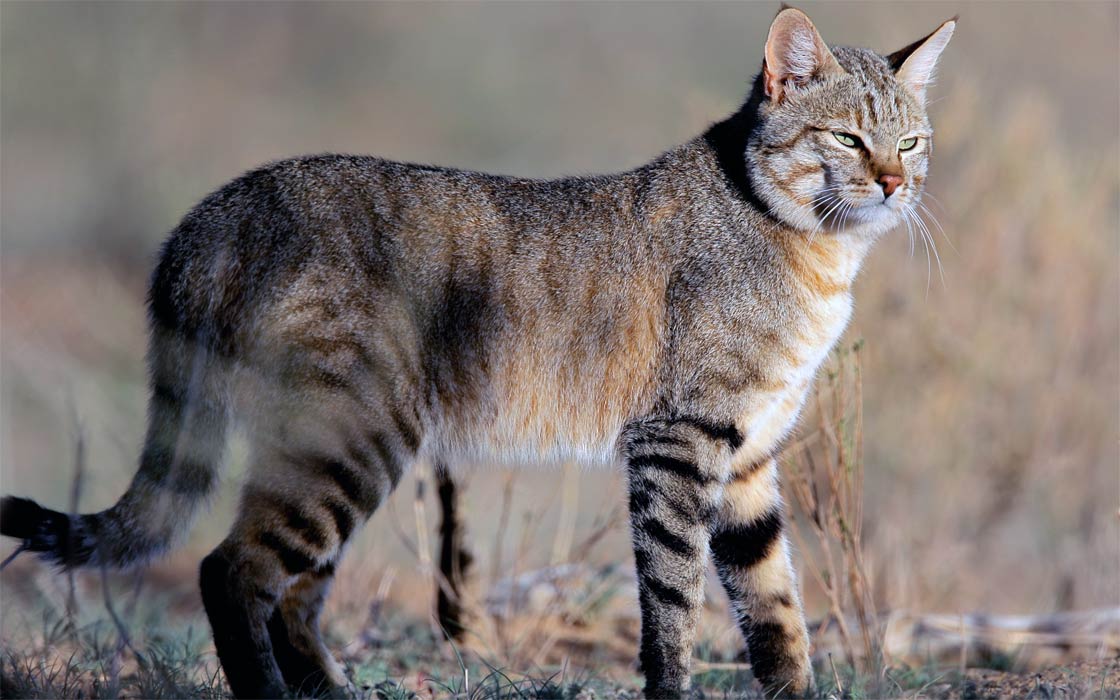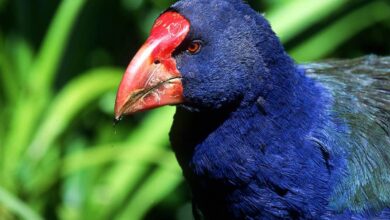African Wildcat – Ancestor of the Domestic Cat
In the heart of the African savanna and in the deserts lives a creature that looks like a domestic purrer, but has a wild heart and thousands of years of independence behind its claws. The African wildcat (Felis lybica) is an agile, solitary hunter, considered the ancestor of all domestic cats. Although it may seem inconspicuous, it copes perfectly in extreme conditions – from rocky deserts to dense thickets. Its quiet steps and watchful gaze are the result of millions of years of evolution in the shadow of larger predators. It lives by its own rules, avoids people, but it is with this cat that humans forged one of the most extraordinary alliances in history. Today, even though its descendants purr on sofas, the African wildcat still roams wild spaces, free and elusive.
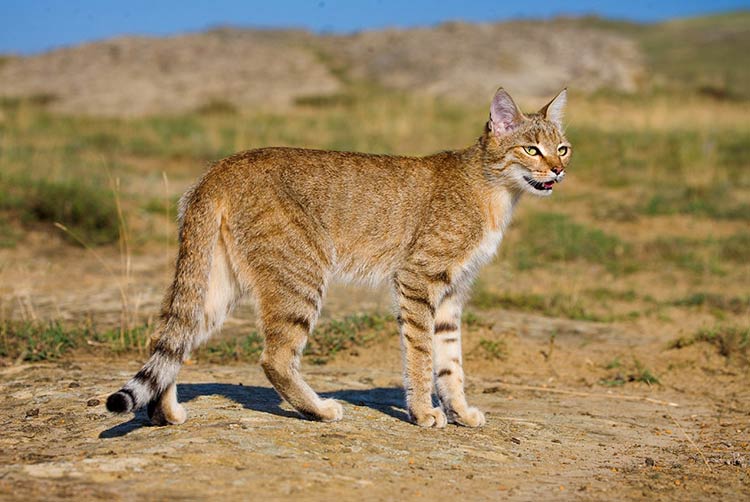
Classification
- Kingdom: Animalia
- Phylum: Chordata
- Class: Mammalia
- Order: Carnivora
- Family: Felidae
- Genus: Felis
- Species: Felis lybica
Some classifications treat the African wildcat as a subspecies of the European wildcat (Felis silvestris lybica), however, more recent genetic and morphological analyses support its status as a separate species – Felis lybica.
Subspecies
The African wildcat (Felis lybica) includes several subspecies, which differ mainly in their geographic range and minor morphological features. The most important subspecies include:
- Felis lybica lybica – the most common subspecies, found in North Africa, including the Sahara and Arabian Peninsula regions. It has sandy or greyish-brown fur that perfectly camouflages it in desert and semi-desert environments.
- Felis lybica ornata – occurs in Central Asia, in the regions of Iran, Pakistan, and Afghanistan. This subspecies is slightly lighter in color compared to Felis lybica lybica, with more distinct stripes on the body and tail.
- Felis lybica ciscaucasica – inhabits the eastern Caucasus and the areas around the Caspian Sea. It is characterized by slightly darker fur, adapted to mountainous terrain.
Some of these subspecies may also differ in behavior, but generally, African wildcats have a very similar way of life, regardless of their location.
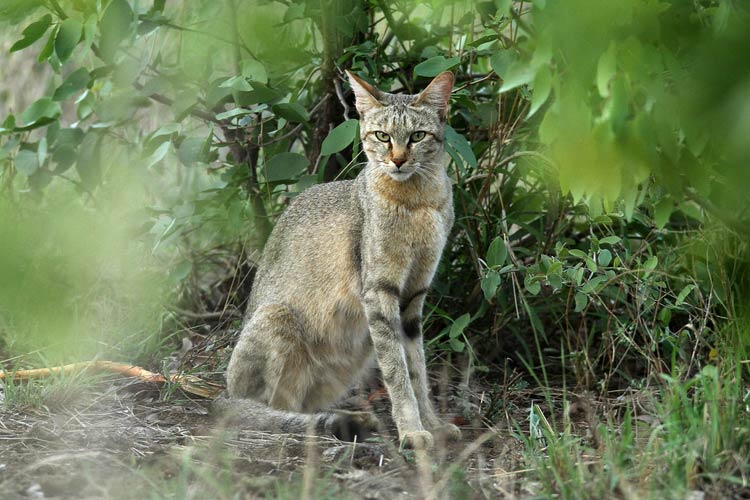
Distribution
The African wildcat (Felis lybica) inhabits vast areas of North Africa, Sub-Saharan Africa, and the Middle East, extending as far as the western edges of Central Asia. It is found in a variety of environments – from arid deserts and semi-deserts, through savannas, to rocky hills and dry thickets. It avoids dense tropical forests and heavily urbanized areas.
It is particularly numerous in the Sahara region, the Arabian Peninsula, and the Nile Valley. The ability to live in extremely dry conditions makes it one of the best-adapted felids to life in areas with limited access to water. Although it leads a secretive lifestyle and is rarely seen, its presence is confirmed by tracks, camera trap footage, and observations by local communities.
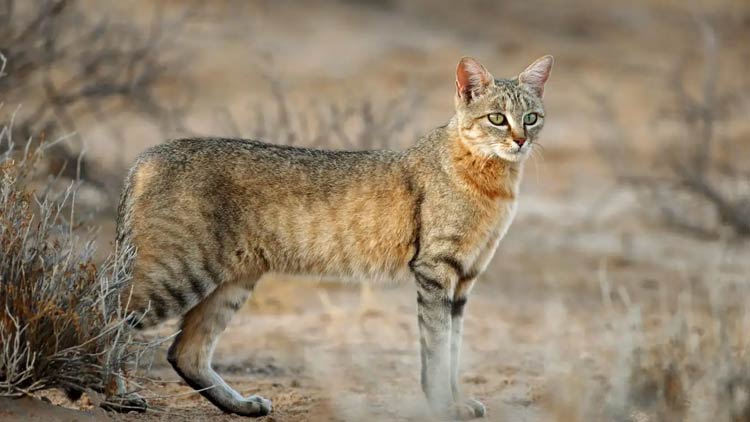
Characteristics
Appearance
The African wildcat (Felis lybica) resembles an average domestic cat in appearance, but its build is more slender, and its limbs are slightly longer. The body length is usually 45–60 cm (18–24 inches), the tail is 25–35 cm (10–14 inches) long, and the body weight ranges from 3 to 4.5 kg (6.6 to 9.9 pounds). The coat has a sandy or greyish-brown hue, which provides excellent camouflage in the desert environment; darker stripes are visible on the limbs and tail, and the end of the tail is black.
The ears are relatively large and rounded, which helps in picking up even the faintest sounds. The African wildcat has excellent eyesight and hearing, and its lifestyle is mainly nocturnal – it avoids the heat of the day, hunting at dusk and night. It moves quietly and cautiously, is solitary and territorial, and avoids contact with other members of its species outside the breeding season.
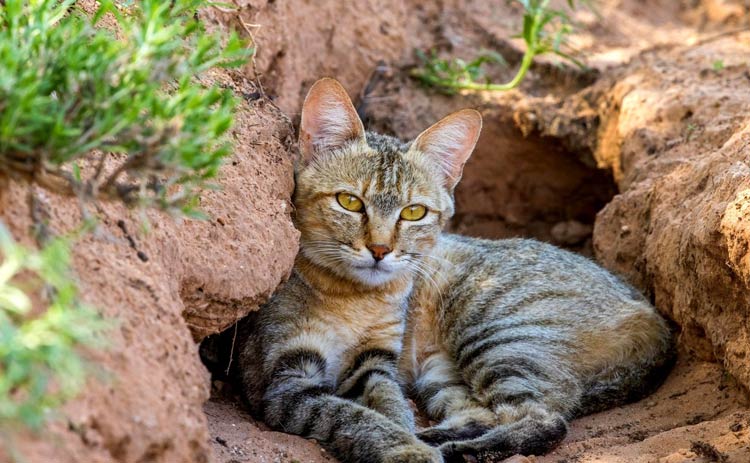
Diet
The African wildcat mainly hunts small vertebrates. Its diet consists primarily of rodents, birds, lizards, as well as insects and other invertebrates – depending on the availability of food in a given environment. It may occasionally attack young hares, and near human settlements, it may also prey on poultry.
It is an opportunistic hunter that can lie motionless for hours to pounce on its prey with lightning speed from ambush. It does not need to hunt every day – if it catches prey larger than it can eat at once, it can hide it and return to it later. Importantly, the African wildcat can go for long periods without drinking – it obtains water mainly from its food and from the metabolism of fats contained in meat.
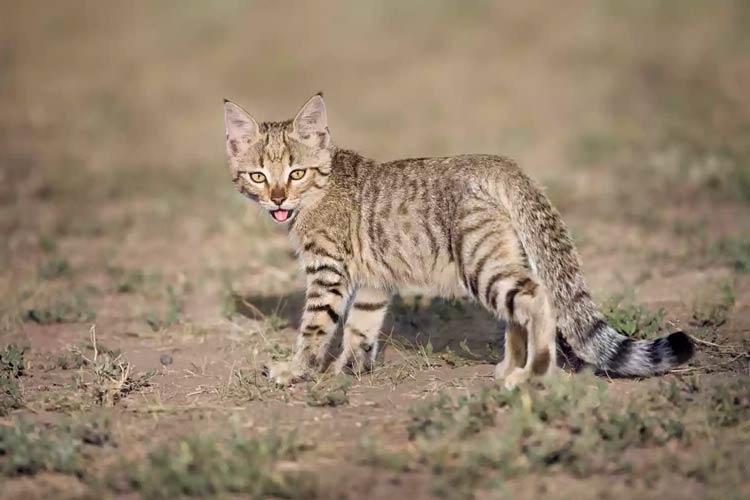
Behavior, lifestyle, and ecology
The African wildcat leads a solitary lifestyle and is mainly active at night and at dusk (nocturnal and crepuscular). During the day, it hides in dense vegetation, rock crevices, or in burrows dug by other animals. Male territories are usually larger than those of females and may overlap, but individual animals avoid direct contact – they communicate mainly through scent marking, territorial marking, and vocalizations.
The African wildcat is very alert and avoids confrontation with larger predators. Thanks to its excellent hearing and eyesight, it can detect threats from a long distance. Its way of moving – quiet, cautious, with a low-slung body – allows it to both avoid predators and hunt effectively.
It is an important element of local ecosystems, playing the role of a regulator of small mammal and other small animal populations. Although it is sometimes seen near human settlements, it avoids direct contact with people, and its domestication – initiated several thousand years ago in ancient Egypt – has not changed the wild nature of today’s populations.
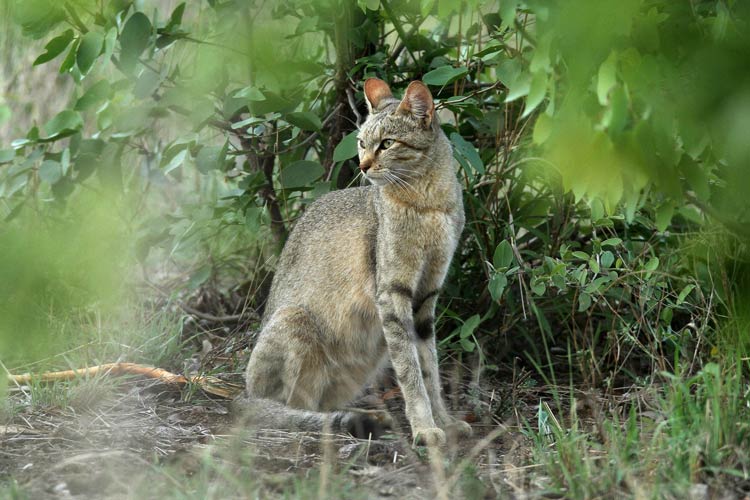
Reproduction and parenting
The African wildcat does not have a strictly defined breeding season, although in some regions it reproduces more frequently during the dry season. Males are attracted to females by secreted pheromones and vocalizations – including loud meowing and purring. After a short courtship period, mating occurs, after which the male leaves the female and does not participate in raising the offspring.
Gestation lasts approximately 56–69 days, and the female gives birth to 1 to 5 young in a hidden burrow, rock crevice, or dense bush. Kittens are born blind and helpless, but after about 10 days they open their eyes, and after a month they begin to leave the den under the care of their mother. Mother’s milk is the basis of their diet for the first 6–8 weeks, after which they gradually learn to hunt by imitating the adult.
The young remain with their mother for several months until they become independent. They reach sexual maturity at around 10–12 months of age. In the wild, the African wildcat typically lives for 10–12 years, although in captivity it can live up to 15–18 years.
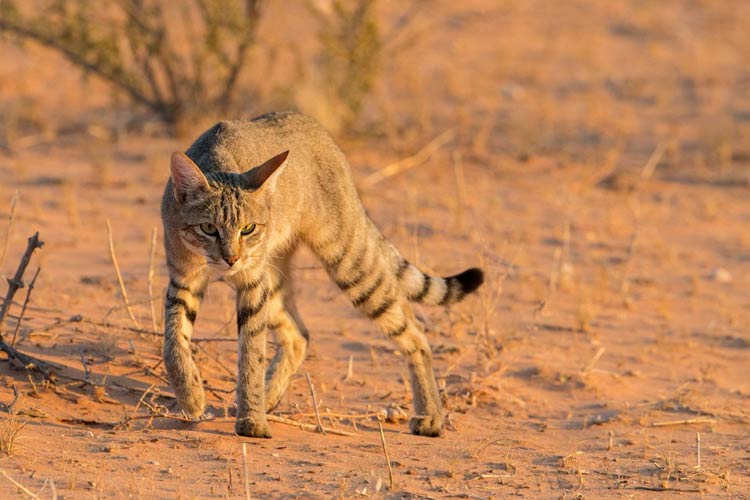
Threats
Although relatively widespread, the African wildcat faces numerous threats mainly resulting from human activities. One of the most serious problems is habitat loss due to urbanization, agriculture, and infrastructure development, which fragments its natural environment and limits access to shelters and food sources.
Another significant threat is interbreeding with domestic cats (Felis catus), which leads to genetic dilution of the wild population. Such hybrids often do not retain wild behavior and may have a reduced ability to survive in natural conditions.
In addition, domestic cats transmit infectious diseases that can be fatal to wild individuals of the species, especially in isolated populations. In some regions, the African wildcat is also a target of hunting – both for its fur and due to misconceptions about its impact on livestock.
Despite this, the International Union for Conservation of Nature (IUCN) currently classifies it as a “Least Concern” species, mainly due to its wide range. However, local populations may be severely threatened and require conservation efforts and monitoring.
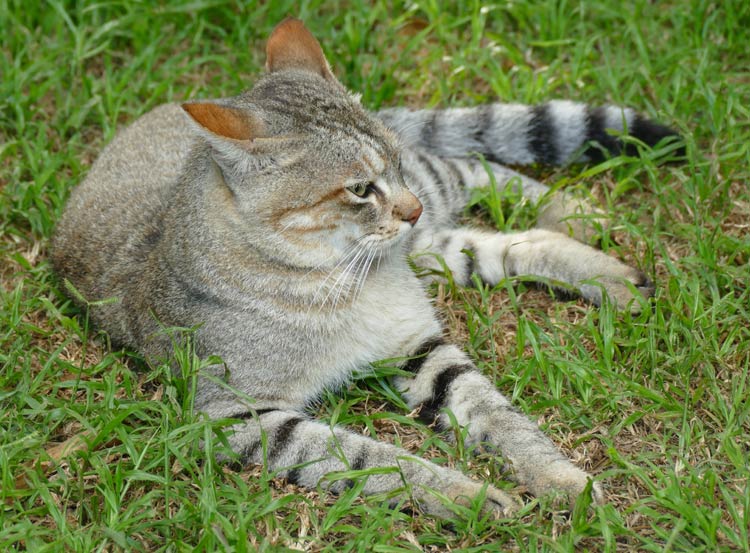
Detailed data / dimensions
African wildcat (Felis lybica)
- Body length: 45–60 cm (18–24 inches)
- Tail length: 25–37 cm (10–15 inches)
- Weight: 3–4.5 kg (6.6–9.9 pounds)
- Lifespan:
- In the wild: 10–12 years
- In captivity: up to 15–18 years
- Maximum speed: 48 km/h (30 mph)
Dimensions may vary slightly depending on the population and environmental conditions – cats from drier regions tend to be more slender and lighter.
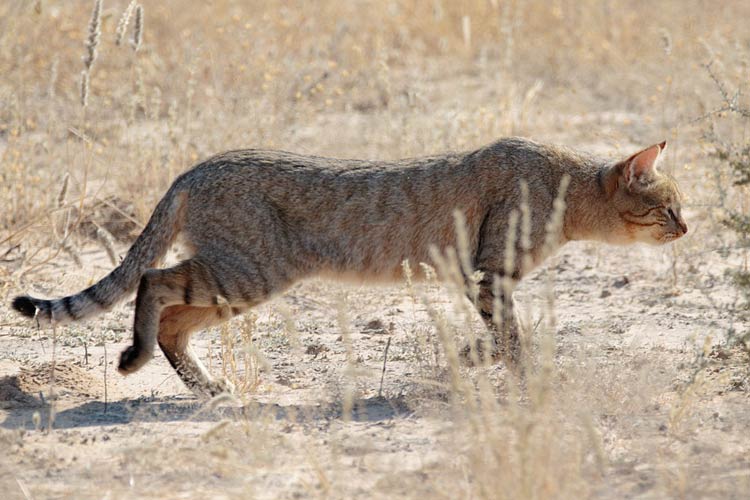
African wildcat – interesting facts
- Ancestor of the domestic cat
It is believed that the African wildcat was domesticated around 10,000 – 9,000 years ago in the Middle East and Egypt, giving rise to all modern domestic cats. - Does not need to drink water
Thanks to metabolic adaptations, it can survive long periods without direct access to water – it obtains it mainly from its food. - Excellent hearing
Its ears pick up ultrasounds emitted by rodents – it can hear the squeak of a mouse from a distance of several dozen meters. - Life in the shadow of civilization
Although wild, it is sometimes seen on the outskirts of human settlements, especially where easy prey is available – such as birds, rodents, or food scraps. - Reluctantly meows
Unlike the domestic cat, it rarely makes sounds – mainly during the mating season or in threatening situations. - Different subspecies
The African wildcat is divided into several subspecies that differ slightly in coloration and build, e.g., Felis lybica lybica from North Africa or Felis lybica ornata from Asia.

Recommended
- Bengal cat
- Chinese mountain cat
- Leopard cat
- Tiger – the king of the jungle
- Siberian tiger
- Bengal tiger
- Sumatran tiger
- Indochinese tiger
- Malayan tiger
- South China tiger
- Tigers
- White tigers
- Lions
- White lions
- Lion vs tiger
- Liger
- Animal fights
- American lion
- European cave lion
- Smilodon – Saber-toothed tiger
- Fights of animals
- Big cats
- Black panther
- Leopard
- Snow leopard
- African Lion
- Fastest animals
- Fastest birds

